University of Buenos Aires
The University of Buenos Aires (Spanish: Universidad de Buenos Aires, UBA) is a public research university in Buenos Aires, Argentina. Established in 1821, it is the premier institution of higher learning in the country and one of the most prestigious universities in the region.[6][7][8][9] It has educated 17 Argentine presidents, produced four of the country's five Nobel Prize laureates, and is responsible for approximately 40% of the country's research output.[10][11][12] The QS World University Rankings currently places the UBA at number 66 in the world.[13]
Universidad de Buenos Aires | |
 | |
| Motto | Argentum virtus robur et studium (Latin) |
|---|---|
Motto in English | Argentine virtue is strength and study |
| Type | Public |
| Established | 1821 |
| Budget | US$700 million (2015)[1] |
| Rector | Dr. Alberto Barbieri |
Academic staff | 28,943 (2004)[2] |
| Students | 328,361 (2012)[3] |
| Undergraduates | 297,639 (2004)[4] |
| Postgraduates | 30,000 (2018)[5] |
| Location | , |
| Campus | Urban |
| Colors | |
| Website | www.uba.ar |
The university's academic strength and regional leadership make it attractive to many international students, especially at the postgraduate level.[14][15] Just over 4 percent of undergraduates are foreigners, while 15 percent of postgraduate students come from abroad.[16] The Faculty of Economic Sciences has the highest rate of international postgraduate students at 30 percent, in line with its reputation as a "top business school with significant international influence."[17][18]
The University of Buenos Aires enrolls more than 328,000 students and is organized into 13 independent faculties.[19][20] It administers 6 hospitals,[21] 16 museums,[22] 13 scientific institutes,[23] 6 interdisciplinary commissions,[24] 5 high schools,[25] the Ricardo Rojas Cultural Center,[26] the Cosmos Cinema,[27] the University of Buenos Aires Symphony Orchestra,[28] and Eudeba (Editorial Universitaria de Buenos Aires), the country's largest university press.[29]
Undergraduate programs at the University of Buenos Aires are free of charge for everyone, regardless of nationality.[30] Tuition from postgraduate programs helps fund the UBA's social mission to provide free university education for all.[31]
Common Basic Cycle
Entry to any of the available programs of study in the university is open to anyone with a secondary school degree; in most cases, students who have successfully completed high school must pass a first year called CBC, which stands for Common Basic Cycle (Ciclo Básico Común). This program was designed to ensure a standardized academic background for all students seeking undergraduate degrees at the UBA.[32]
The CBC consists of 6 or 7 subjects (which vary depending on the chosen faculty's program of study), each having one semester duration (March–July or August–November), and are often taken in groups of 3 or 4 subjects per semester. Thus, it's possible for the Cycle to take only one year, though students are given up to three years to finish it. Potential students of economics, instead, take a 2-year common cycle, the "CBG" (General Basic Cycle), comprising 12 subjects.
Only upon completion may the student enter the chosen faculty; until then, they must attend courses in different buildings depending on where they are available.
Faculties





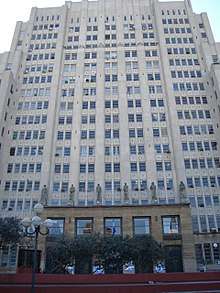

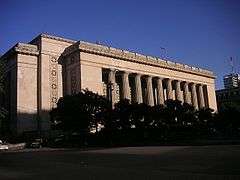
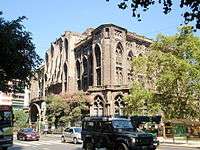
The faculties that comprise the university are:
- Ciclo Básico Común
- Facultad de Psicología (psychology)
- Facultad de Ingeniería (engineering)
- Facultad de Odontología (dentistry)
- Facultad de Farmacia y Bioquímica (pharmacy and biochemistry)
- Facultad de Filosofía y Letras (philosophy and literature)
- Facultad de Derecho (law)
- Facultad de Medicina (medicine)
- Facultad de Ciencias Sociales (social sciences)
- Facultad de Veterinaria (veterinary medicine)
- Facultad de Agronomía (agronomy)
- Facultad de Ciencias Económicas (economics)
- Facultad de Ciencias Exactas y Naturales (exact science and natural science)
- Facultad de Arquitectura, Diseño y Urbanismo (architecture, design and urbanism)
Of these, only the last two have their buildings located in then centralized Ciudad Universitaria (literally, "university city"), a campus-like location in Núñez, in northern Buenos Aires along the banks of the Río de la Plata. The others are scattered around the city in buildings of various sizes, with some having more than one building.
The Faculty of Economic Sciences is the largest of the UBA's constituent colleges, with over 36,000 students.[33] In recent years, the Faculty of Medicine has attracted the most new students, with 17,004 new enrollees in 2018 compared to the 7,584 new students the Faculty of Economic Sciences added that same year.[34]
In addition to these 13 faculty and the CBC, the UBA also administers 5 high schools: Colegio Nacional de Buenos Aires, Escuela Superior de Comercio Carlos Pellegrini, Instituto Libre de Segunda Enseñanza, Escuela de Educación Técnica Profesional en Producción Agropecuaria y Agroalimentaria, and Escuela de Educación Técnica de Villa Lugano.[35]
Notable alumni
- Luis Agote, physician
- Diana Agrest, Argentine born American architect and theorist
- Viviana Alder, marine microbiologist, Argentine Antarctic researcher
- Tristan Bekinschtein, cognitive neuroscientist.
- Cecilia Berdichevsky, pioneering Argentinian computer scientist
- Teodosio Cesar Brea, lawyer and founder of Allende & Brea
- Alejandro Bulgheroni, oil billionaire[36]
- Juan Cabral, film director
- Alicia Beatriz Casullo (1940–2019), psychoanalyst
- Luis Caffarelli, mathematician
- Alberto Calderón, mathematician
- Enrique Chaneton, ecologist
- Primarosa Chieri, geneticist
- Julio Cortázar, writer
- Augusto Claudio Cuello, Professor and Charles E. Frosst/Merck Chair in Pharmacology and Therapeutics at McGill University
- Che Guevara, revolutionary leader and physician
- Esther Hermitte, anthropologist
- Salvador Maciá, physician and politician
- Jose Pedro Montero De Candia, 27th President of Paraguay
- Luis Moreno-Ocampo, lawyer, jurist and Chief Prosecutor of the International Criminal Court
- Élida Passo (1867–1893), first Argentine woman pharmacist and first South American woman university graduate[37]
- Patricio Pouchulu, architect and educator
- Alberto Prebisch, architect
- Raul Prebisch, economist
- Elena Presser, artist
- Teresa Ratto, physician
- Juan Rosai, physician, Italian-born American surgical pathologist
- José Luis Murature, foreign minister of Argentina
- Irene Schloss, plankton biologist, Argentine Antarctic researcher
- Samanta Schweblin, writer
- Clorindo Testa, architect and painter
- Richard Tomlinson, former British spy
- Claudio Vekstein, architect specialized in public architecture
- Rafael Viñoly, Uruguayan architect
- Inés Mónica Weinberg de Roca, lawyer, former Judge at the International Criminal Tribunal for Rwanda
- Graciela Boente , mathematician
- Horacio Anasagasti, engineer
The following former students and professors of the university have received the Nobel Prize:
- Carlos Saavedra Lamas, Peace, 1936.
- Bernardo Houssay, Physiology, 1947.
- Luis Federico Leloir, Chemistry, 1970.
- César Milstein, Medicine, 1984.
The following Presidents of Argentina have earned their degrees at the university:
- José Evaristo Uriburu (1896-1898, National Autonomist Party), lawyer.
- Carlos Pellegrini (1890–1892, National Autonomist Party), lawyer.
- Luis Sáenz Peña (1892–1895, National Autonomist Party), lawyer.
- Manuel Quintana (1904–1906, National Autonomist Party), lawyer.
- Roque Sáenz Peña (1910–1914, National Autonomist Party), lawyer.
- Victorino de la Plaza (1914–1916, National Autonomist Party), lawyer.
- Hipólito Yrigoyen (1916–1922 and 1928–1930, Radical Civic Union), lawyer.
- Marcelo Torcuato de Alvear (1922–1928, Radical Civic Union), lawyer.
- Agustín Pedro Justo (1932–1938, "Concordancia" alliance), engineer.
- Roberto Marcelino Ortiz (1938–1942, "Concordancia" alliance), lawyer.
- Ramón Castillo (1942–1943, "Concordancia" alliance), lawyer.
- Arturo Frondizi (1958–1962, Intransigent Radical Civic Union), lawyer.
- Arturo Umberto Illia (1963–1966, People's Radical Civic Union), physician.
- Raúl Alfonsín (1983–1989, Radical Civic Union), lawyer.
- Adolfo Rodríguez Saá (2001, Justicialist Party), lawyer.
- Eduardo Duhalde (2002–2003, Justicialist Party), lawyer.
- Alberto Fernández (2019–present, Justicialist Party), lawyer.
Deans
- Dr. Antonio Sáenz 13-06-1821 to 25-07-1825.
- Dr. José Valentín Gómez 10-04-1826 to 23-08-1830.
- Dr. Santiago Figueredo 23-08-1830 to 22-02-1832.
- Dr. Paulino Gari 13-12-1832 to 11-1849.
- Dr. Miguel García 11-1849 to 26-06-1852.
- Dr. José Barros Pazos 01 -07-1852 to 5-05-1857.
- Dr. Antonio Cruz Obligado 9-05-1857 to 03-1861.
- Dr. Juan María Gutiérrez 1-04-1861 to 3-10-1873.
- Dr. Vicente Fidel López 15-02-1874 to 12-06-1877.
- Dr. Manuel Quintana 12-06-1877 to 26-01-1881.
- Dr. Eufemio Uballes 1-03-1906 to 1-03-1922.
- Dr. José Arce 1-03-1922 to 1-03-1926.
- Dr. Ricardo Rojas 2-03-1926 to 1-03-1930.
- Dr. Enrique Butty 1-03-1930 to 11-12-1930.
- Dr. Benito Nazar Anchorena (interventor) 16-12-1930 to 1-06-1931.
- Dr. Mariano Castex 1-06-1931 to 9-03-1932.
- Dr. Ángel Gallardo 11-05-1932 to 9-04-1934.
- Dr. Vicente Gallo 11-05-1934 to 11-05-1941.
- Dr. Coroliano Alberini 12-05-1941 to 16-10-1941.
- Dr. Carlos Saavedra Lamas 17-10-1941 to 30-07-1943.
- Dr. Alfredo Labougle (vice-rector) 31-07-1942 to 1-11-1943.
- Dr. Emilio Ravignani (interventor) 2-11-1943 to 4-11-1943.
- Dr. Tomás Casares (interventor) 4-11-1943 to 9-03-1944.
- Dr. David Arias (interventor) 10-03-1944 to 18-05-1944.
- Dr. Carlos Obligado (interventor) 19-05-1944 to 31-08-1944.
- Dr. Nicolás Matienzo (gen. secretary at charge) 1-09-1944 to 30-10-1944.
- Dr. Carlos Waldorp (interventor) 30-10-1944 to 16-02-1945.
- Dr. Antonio Benítez (national commissioner) 17-02-1945 to 14-03-1945.
- Dr. Salvador Oría (vice-rector) 15-03-1945 to 26-04-1945.
- Dr. Horacio Rivarola 27-04-1945 to 2-05-1946.
- Dr. Nicolás Matienzo (gen. secretary at charge) 2-05-1946 to 2-05-1946.
- Dr. Oscar Ivanissevich (interventor) 4-05-1946 to 5-06-1949.
- Dr. Fernando Bustos (vice-rector interventor) 6-08-1946 to 2-09-1946.
- Dr. Agustín Nores Martínez (by the interventor's delegation) 3-09-1946 to 20-09-1946.
- Dr. Fernando Bustos (vice-rector interventor) 21-09-1946 to 24-01-1947.
- Ing. Agr. Carlos Emery (vice-rector interventor) 3-02-1947 to 19-08-1947.
- Arq. Julio Otaola (vice-rector interventor) 20-08-1947 to 5-06-1949.
- Arq. Julio Otaola 6-06-1949 to 12-06-1952.
- Dr. Carlos Bancalari 13-06-1952 to 16-10-1953.
- Dr. José Fernández Moreno (vice-rector) 17-10-1953 to 3-11-1953.
- Dr. Jorge Alberto Taiana 4-11-1953 to 3-06-1955.
- Dr. Ernesto Crámer 4-06-1955 to 31-07-1955.
- Dr. Ernesto Cholvis 1-08-1955 to 26-09-1955.
- Provisory Government Board (FUBA) 27-09-1955 to 30-09-1955.
- Dr. José Luis Romero 1-10-1955 to 31-12-1955.
- Ing. José Babini 1-01-1956 to 19-02-1956.
- Dr. Alejandro Ceballos 5-05-1956 to 27-12-1957.
- Dr. Risieri Frondizi 27-12-1957 to 28-12-1962.
- Dr. Julio Olivera 28-12-1962 to 18-03-1965.
- Ing. Hilario Fernández Long 26-03-1965 to 29-07-1966.
- Dr. Luis Botet 11-08-1966 to 7-02-1968.
- Dr. Raúl Devoto 7-02-1968 to 24-07-1969.
- Dr. Andrés Santas 25-07-1969 to 21-07-1971.
- Dr. Bernabé Quartino 22-07-1971 to 29-01-1973.
- Dr. Carlos Alberto Durrieu 29-01-1973 to 30-05-1973.
- Dr. Rodolfo Puiggrós (interventor) 29-05-1973 to 2-10-1973.
- Ing. Enrique Martínez (interventor) 7-09-1973 to 2-10-1973.
- Lic. Ernesto Villanueva 4-10-1973 to 28-03-1974.
- Dr. Vicente Solano Lima 28-03-1974 to 25-07-1974.
- Dr. Raúl Federico Laguzzi 25-07-1974 to 17-09-1974.
- Dr. Alberto Ottalagano (interventor) 17-09-1974 to 26-12-1974.
- Eduardo Mangiante 27-08-1975 to 12-02-1976.
- Dr. José Alocén 12-02-1976 to 24-03-1976.
- Cap.Navío De Edmundo E. Said 29-03-1976 to 6-08-1976.
- Ing. Alberto Costantini 6-08-1976 to 14-09-1976.
- Dr. Sol Rabasa 14-09-1976 to 25-02-1977.
- Dr. Luis Carlos Cabral 25-02-1977 to 31-08-1978.
- Dr. Alberto V. Donnes 31-08-1978 to 23-11-1978.
- Dr. Lucas Lennon 24-11-1978 to 20-11-1981.
- Dr. Alberto V. Donnes 20-11-1981 to 28-12-1981.
- Dr. Alberto Rodríguez Varela 28-12-1981 to 23-12-1982.
- Dr. Carlos Segovia Fernández 27-12-1982 to 23-12-1983.
- Dr. Francisco Delich 26-12-1983 to 19-03-1985.
- Dr. Oscar Julio Shuberoff 19-03-1985 to 06-05-2002.
- Dr. Guillermo Jaim Etcheverry 07-05-2002 to 07-05-2006.
- Arq.Berardo Dujovne (acting) 08-05-2006 to 15-05-2006.
- Dr. Alfredo Buzzi (acting) 16-05-2006 to 29-05-2006.
- Dr. Alberto Boveris (acting) 29-05-2006 to 31-05-2006
- Med. Vet.Aníbal Franco (vice-rector) 31-05-2006 to 12-12-2006.
- Dr. Alfredo Buzzi (acting) 12-12-2006 to 18-12-2006.
- Méd. Vet. Rubén E. Hallú 18-12-2006 to 4-12-2013.
- Prof. Dr. Alberto Barbieri 5-12-2013 to present.
Gallery of notable alumni
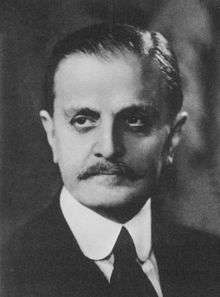 Carlos Saavedra Lamas, Nobel Peace Prize, 1936.
Carlos Saavedra Lamas, Nobel Peace Prize, 1936.- Bernardo Houssay, Nobel Prize in Medicine, 1947.
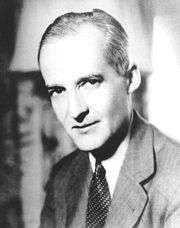 Luis Federico Leloir, Nobel Prize in Chemistry, 1970.
Luis Federico Leloir, Nobel Prize in Chemistry, 1970. César Milstein, Nobel Prize in Medicine, 1984.
César Milstein, Nobel Prize in Medicine, 1984.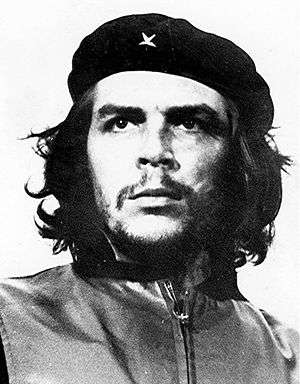 Ernesto "Che" Guevara, Marxist leader.
Ernesto "Che" Guevara, Marxist leader. Carlos Pellegrini, president 1890-1892.
Carlos Pellegrini, president 1890-1892. Luis Sáenz Peña, president 1892-1895.
Luis Sáenz Peña, president 1892-1895.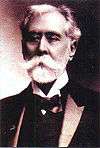 Manuel Quintana, president 1904-1906.
Manuel Quintana, president 1904-1906. Victorino de la Plaza, president 1914-1916
Victorino de la Plaza, president 1914-1916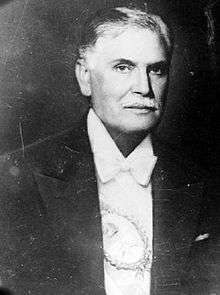 Ramón S. Castillo, president 1942-1943
Ramón S. Castillo, president 1942-1943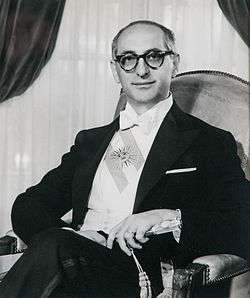 Arturo Frondizi, president 1958-1962
Arturo Frondizi, president 1958-1962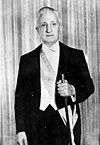 Arturo Umberto Illia, president 1963-1966
Arturo Umberto Illia, president 1963-1966- Adolfo Rodríguez Saá, president 2001
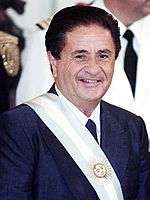 Eduardo Duhalde, president 2002-2003
Eduardo Duhalde, president 2002-2003.jpg) Alberto Fernández, president 2019–present
Alberto Fernández, president 2019–present
See also
- Argentine university reform of 1918
- List of Argentine universities
- Science and technology in Argentina
References
- University of Buenos Aires, Budget
- University of Buenos Aires, 2004 Academic Staff Census
- 2012 Student Census
- University of Buenos Aires, 2004 Academic Staff Census
- "Best Global Universities in Latin America". U.S. News and World Report. 2019.
- "ARWU World University Rankings 2018 | Academic Ranking of World Universities 2018 | Top 500 universities | Shanghai Ranking - 2018". www.shanghairanking.com. Retrieved 2019-05-15.
- "Top Universities in Argentina | 2019 Argentine University Ranking". www.4icu.org. Retrieved 2019-05-15.
- "Top Universities - Argentina | CWUR World University Rankings 2018-2019". cwur.org. Retrieved 2019-05-15.
- "Quince presidentes argentinos estudiaron Derecho en la UBA". Diario Judicial (in Spanish). Retrieved 2019-05-04.
- "UBA Internacional". www.uba.ar. Retrieved 2019-05-03.
- "Encrucijadas". www.uba.ar. Retrieved 2019-05-04.
- "QS World University Rankings® 2019". Quacquarelli Symonds. Retrieved 20 February 2018.
- "De qué países son los extranjeros que vienen a estudiar a la Argentina". www.lanacion.com.ar (in Spanish). 2017-11-09. Retrieved 2019-05-04.
- Fernandez, Maximiliano (24 February 2018). "Estudiantes extranjeros en Capital: de qué países vienen y qué carreras eligen". Infobae (in Spanish). Retrieved 2019-05-04.
- Fern, Por Maximiliano; Mafern, Ez 19 De Abril De 2018. "Aumentaron un 22% los alumnos extranjeros en la Ciudad: buscan llegar a los 100 mil por año". Infobae (in Spanish). Retrieved 2019-05-04.
- "Más alumnos extranjeros eligen cursar posgrados en la UBA". www.lanacion.com.ar (in Spanish). 2018-05-02. Retrieved 2019-05-05.
- "University and business school ranking in Argentina". www.eduniversal-ranking.com. Retrieved 2019-05-04.
- "Población estudiantil de instituciones universitarias de la Ciudad de Buenos Aires. Año 2012" (PDF). Estadística y Censos.
- Universidad de Buenos Aires. "Facultades". www.uba.ar. Retrieved 2019-05-04.
- "Red Hospitalaria". www.uba.ar. Retrieved 2019-05-04.
- "Red de museos". www.uba.ar. Retrieved 2019-05-04.
- cyt.rec.uba.ar http://cyt.rec.uba.ar/Paginas/Institutos.aspx. Retrieved 2019-05-15. Missing or empty
|title=(help) - "Programas Interdisciplinarios". www.uba.ar. Retrieved 2019-05-15.
- "Colegios de educación media". www.uba.ar. Retrieved 2019-05-05.
- "Centro Cultural Ricardo Rojas". www.rojas.uba.ar. Retrieved 2019-05-15.
- "Universidad de Buenos Aires". www.uba.ar. Retrieved 2019-05-15.
- "Universidad de Buenos Aires". www.uba.ar. Retrieved 2019-05-15.
- "Para festejar: Eudeba cumple 60 años". www.lanacion.com.ar (in Spanish). 2018-06-24. Retrieved 2019-05-05.
- "UBA Internacional". www.uba.ar. Retrieved 2019-05-04.
- "ESTATUTO UNIVERSITARIO" (PDF). Universidad de Buenos Aires.
- "UBA - CBC". www.cbc.uba.ar. Retrieved 2019-05-04.
- "Censo de Estudiantes 2011" (PDF). Universidad de Buenos Aires.
- Fern, Por Maximiliano; Mafern, Ez 6 De Abril De 2018. "Récord de inscriptos al CBC de la UBA: cuáles son las carreras más elegidas". Infobae (in Spanish). Retrieved 2019-05-04.
- "Universidad de Buenos Aires". www.uba.ar. Retrieved 2019-05-04.
- "Alejandro Pedro Bulgheroni". BusinessWeek. Retrieved 9 January 2015.
- Itatí Palermo, Alicia (July–December 2006). "El acceso de las mujeres a la educación universitaria" [Women's Access to University Education]. Revista argentina de sociología (in Spanish). 4 (7). ISSN 1669-3248. Archived from the original on 2019-12-14. Retrieved 2020-05-19 – via SciELO.
External links
| Wikimedia Commons has media related to Universidad de Buenos Aires. |
- Official website (in Spanish)
- Study in Argentina: argentine government website for international students (in English)